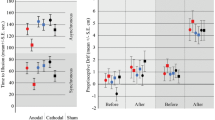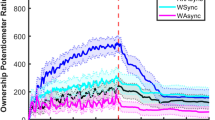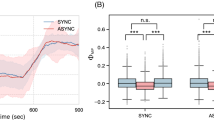Abstract
Rubber hand illusion (RHI) is an important phenomenon for the investigation of body ownership and self/other distinction. The illusion is promoted by the spatial and temporal contingencies of visual inputs near a fake hand and physical touches to the real hand. The neural basis of this phenomenon is not fully understood. We hypothesized that the RHI is associated with a fronto-parietal circuit, and the goal of this study was to determine the dynamics of neural oscillation associated with this phenomenon. We measured electroencephalography while delivering spatially congruent/incongruent visuo-tactile stimulations to fake and real hands. We applied time–frequency analyses and calculated renormalized partial directed coherence (rPDC) to examine cortical dynamics during the bodily illusion. When visuo-tactile stimulation was spatially congruent, and the fake and real hands were aligned, we observed a reduced causal relationship from the medial frontal to the parietal regions with respect to baseline, around 200 ms post-stimulus. This change in rPDC was negatively correlated with a subjective report of the RHI intensity. Moreover, we observed a link between the proprioceptive drift and an increased causal relationship from the parietal cortex to the right somatosensory cortex during a relatively late period (550–750 ms post-stimulus). These findings suggest a two-stage process in which (1) reduced influence from the medial frontal regions over the parietal areas unlocks the mechanisms that preserve body integrity, allowing RHI to emerge; and (2) information processed at the parietal cortex is back-projected to the somatosensory cortex contralateral to the real hand, inducing proprioceptive drift.




Similar content being viewed by others
References
Apps MA, Tsakiris M (2014) The free-energy self: a predictive coding account of self-recognition. Neurosci Biobehav Rev 41:85–97. doi:10.1016/j.neubiorev.2013.01.029
Asai T (2015) Illusory body-ownership entails automatic compensative movement: for the unified representation between body and action. Exp Brain Res 233:777–785. doi:10.1007/s00221-014-4153-0
Asai T, Mao Z, Sugimor E, Tanno Y (2011) Rubber hand illusion, empathy, and schizotypal experiences in terms of self-other representations. Conscious Cogn 20:1744–1750. doi:10.1016/j.concog.2011.02.005
Baker M (2016) 1500 scientists lift the lid on reproducibility. Nature 533(7604):452–454
Berlucchi G, Aglioti SM (2010) The body in the brain revisited. Exp Brain Res 200:25–35. doi:10.1007/s00221-009-1970-7
Blanke O, Metzinger T (2009) Full-body illusions and minimal phenomenal selfhood. Trends Cogn Sci 13:7–13. doi:10.1016/j.tics.2008.10.003
Blanke O, Mohr C (2005) Out-of-body experience, heautoscopy, and autoscopic hallucination of neurological origin Implications for neurocognitive mechanisms of corporeal awareness and self-consciousness. Brain Res Rev 50:184–199
Botvinick M, Cohen J (1998) Rubber hands ‘feel’ touch that eyes see. Nature 391:756
Botvinick M, Nystrom LE, Fissell K, Carter CS, Cohen JD (1999) Conflict monitoring versus selection-for-action in anterior cingulate cortex. Nature 402:179–181
Botvinick M, Cohen JD, Carter CS (2004) Conflict monitoring and anterior cingulate cortex: an update. Trends Cogn Sci 8:539–546
Brozzoli C, Gentile G, Ehrsson HH (2012) That’s near my hand! parietal and premotor coding of hand-centered space contributes to localization and self-attribution of the hand. J Neurosci 32(42):14573–14582
Cohen MX (2014) Analyzing neural time series data: theory and practice. MIT Press, Massachusetts
Cohen JD, Botvinick M, Carter CS (2000) Anterior cingulate and prefrontal cortex: who’s in control? Nat Neurosci 3:421–423
Corbetta M, Shulman GL (2002) Control of goal-directed and stimulus-driven attention in the brain. Nat Rev Neurosci 3:201–215
De Vignemont F (2007) Habeas corpus: the sense of ownership of one’s own body. Mind Lang 22:427–449. doi:10.1111/j.1468-0017.2007.00315.x
Delorme A, Makeig S (2004) EEGLAB: an open source toolbox for analysis of single-trial EEG dynamics including independent component analysis. J Neurosci Methods 134:9–21
Delorme A, Mullen T, Kothe C, Akalin Acar Z, Bigdely-Shamlo N, Vankov A, Makeig S (2011) EEGLAB, SIFT, NFT, BCILAB, and ERICA: new tools for advanced EEG processing. Comput Intell Neurosci 2011:130714. doi:10.1155/2011/130714
Ehrsson HH, Spence C, Passingham RE (2004) That’s my hand! activity in premotor cortex reflects feeling of ownership of a limb. Science 305:875–877
Ehrsson HH, Holmes NP, Passingham RE (2005) Touching a rubber hand: feeling of body ownership is associated with activity in multisensory brain areas. J Neurosci 25:10564–10573. doi:10.1523/JNEUROSCI.0800-05.2005
Ehrsson HH, Wiech K, Weiskopf N, Dolan RJ, Passingham RE (2007) Threatening a rubber hand that you feel is yours elicits a cortical anxiety response. Proc Natl Acad Sci USA 104:9828–9833
Evans N, Blanke O (2013) Shared electrophysiology mechanisms of body ownership and motor imagery. Neuroimage 64:216–228. doi:10.1016/j.neuroimage.2012.09.027
Gao Q, Duan X, Chen H (2011) Evaluation of effective connectivity of motor areas during motor imagery and execution using conditional Granger causality. Neuroimage 54:1280–1288. doi:10.1016/j.neuroimage.2010.08.071
Gentile G, Guterstam A, Brozzoli C, Ehrsson HH (2013) Disintegration of multisensory signals from the real hand reduces default limb self-attribution: an fMRI study. J Neurosci 33:13350–13366
Gow DW Jr, Segawa JA, Ahlfors SP, Lin FH (2008) Lexical influences on speech perception: a Granger causality analysis of MEG and EEG source estimates. Neuroimage 43:614–623. doi:10.1016/j.neuroimage.2008.07.027
Gramann K, Gwin JT, Bigdely-Shamlo N, Ferris DP, Makeig S (2010) Visual evoked responses during standing and walking. Front Hum Neurosci 4:202. doi:10.3389/fnhum.2010.00202
Groppe DM, Urbach TP, Kutas M (2011) Mass univariate analysis of event-related brain potentials/fields I: a critical tutorial review. Psychophysiology 48:1711–1725. doi:10.1111/j.1469-8986.2011.01273.x
Guterstam A, Gentil G, Ehrsson HH (2013) The invisible hand illusion: multisensory integration leads to the embodiment of a discrete volume of empty space. J Cogn Neurosci 25:1078–1099. doi:10.1162/jocn
Hesse W, Möller E, Arnold M, Schack B (2003) The use of time-variant EEG Granger causality for inspecting directed interdependencies of neural assemblies. J Neurosci Methods 124:27–44
Kalckert A, Ehrsson HH (2014) The moving rubber hand illusion revisited: comparing movements and visuotactile stimulation to induce illusory ownership. Conscious Cogn 26:117–132. doi:10.1016/j.concog.2014.02.003
Kammers MP, Verhagen L, Dijkerman HC, Hogendoorn H, De Vignemont F, Schutter DJ (2009) Is this hand for real? attenuation of the rubber hand illusion by transcranial magnetic stimulation over the inferior parietal lobule. J Cogn Neurosci 21:1311–1320. doi:10.1162/jocn.2009.21095
Kanayama N, Ohira H (2009) Multisensory processing and neural oscillatory responses: separation of visuotactile congruency effect and corresponding electroencephalogram activities. NeuroReport 20:289–293. doi:10.1097/WNR.0b013e328322ca63
Kanayama N, Sato A, Ohira H (2007) Crossmodal effect with rubber hand illusion and gamma-band activity. Psychophysiology 44:392–402
Kanayama N, Tamè L, Ohira H, Pavani F (2012) Top down influence on visuo-tactile interaction modulates neural oscillatory responses. Neuroimage 59:3406–3417. doi:10.1016/j.neuroimage.2011.11.076
Keil A, Sabatinelli D, Ding M, Lang PJ, Ihssen N, Heim S (2009) Re-entrant projections modulate visual cortex in affective perception: evidence from granger causality analysis. Hum Brain Mapp 30:532–540
Keil J, Weisz N, Paul-Jordanov I, Wienbruch C (2010) Localization of the magnetic equivalent of the ERN and induced oscillatory brain activity. Neuroimage 51:404–411. doi:10.1016/j.neuroimage.2010.02.003
Lenggenhager B, Halje P, Blanke O (2011) Alpha band oscillations correlate with illusory self-location induced by virtual reality. Eur J Neurosci 33:1935–1943. doi:10.1111/j.1460-9568.2011.07647.x
Lunn V (1970) Autoscopic phenomena. Acta Psychiatr Scand 46(Supplement s219):118–125
Lütkepohl H (2006) Chapter 6. forecasting with VARMA models. In: Elliott G, Granger CWJ, Timmermann A (eds) Handbook of economic forecasting, vol 1. Elsevier, Amsterdam, pp 287–325. doi:10.1016/S1574-0706(05)01006-2
Luu P, Tucker DM, Makeig S (2004) Frontal midline theta and the error-related negativity: neurophysiological mechanisms of action regulation. Clin Neurophysiol 115:1821–1835
Makeig S, Delorme A, Westerfield M, Jung T-P, Townsend J, Courchesne E, Sejnowski TJ (2004) Electroencephalographic brain dynamics following manually responded visual targets. PLoS Biol 2:e176. doi:10.1371/journal.pbio.0020176
Makin TR, Holmes NP, Ehrsson HH (2008) On the other hand: dummy hands and peripersonal space. Behav Brain Res 191:1–10. doi:10.1016/j.bbr.2008.02.041
Makris N, Kennedy DN, McInerney S, Sorensen AG, Wang R, Caviness VS Jr, Pandya DN (2005) Segmentation of subcomponents within the superior longitudinal fascicle in humans: a quantitative, in vivo, DT-MRI study. Cereb Cortex 15:854–869
Miyakoshi M, Kanayama N, Iidaka T, Ohira H (2010) EEG evidence of face-specific visual self-representation. NeuroImage 50:1666–1675. doi:10.1016/j.neuroimage.2010.01.030
Mullen T, Delorme A, Kothe C, Makeig S (2010) An Electrophysiological Information Flow Toolbox for EEGLAB. Society for Neuroscience Conference, San Diego http://sccn.ucsd.edu/wiki/SIFT
Oostenveld R, Fries P, Maris E, Schoffelen JM (2011) FieldTrip: open source software for advanced analysis of MEG, EEG, and invasive electrophysiological data. Comput Intell Neurosci 2011:156869. doi:10.1155/2011/156869
Open Science Collaboration (2015) Estimating the reproducibility of psychological science. Science 349:4716. doi:10.1126/science.aac4716
Pastötter B, Hanslmayr S, Bäuml KH (2010) Conflict processing in the anterior cingulate cortex constrains response priming. Neuroimage 50:1599–1605. doi:10.1016/j.neuroimage.2010.01.095
Pavani F, Spence C, Driver J (2000) Visual capture of touch: out-of-the-body experiences with rubber gloves. Psychol Sci 11:353–359
Quinn BT, Carlson C, Doyle W, Cash SS, Devinsky O, Spence C, Halgren E, Thesen T (2014) Intracranial cortical responses during visual-tactile integration in humans. J Neurosci 34:171–181. doi:10.1523/JNEUROSCI.0532-13.2014
Sabatinelli D, Frank DW, Wanger TJ, Dhamala M, Adhikari BM, Li X (2014) The timing and directional connectivity of human frontoparietal and ventral visual attention networks in emotional scene perception. Neuroscience 277:229–238. doi:10.1016/j.neuroscience.2014.07.005
Schelter B, Timmer J, Eichler M (2009) Assessing the strength of directed influences among neural signals using renormalized partial directed coherence. J Neurosci Methods 179:121–130. doi:10.1016/j.jneumeth.2009.01.006
Serino A, Sforza AL, Kanayama N, van Elk M, Kaliuzhna M, Herbelin B, Blanke O (2015) Tuning of temporo-occipital activity by frontal oscillations during virtual mirror exposure causes erroneous self-recognition. Eur J Neurosci 42:2515–2526
Thiebaut de Schotten M, Dell’Acqua F, Forkel SJ, Simmons A, Vergani F, Murphy DG, Catani M (2011) A lateralized brain network for visuospatial attention. Nat Neurosci 14:1245–1246. doi:10.1038/nn.2905
Trujillo LT, Allen JJ (2007) Theta EEG dynamics of the error-related negativity. Clin Neurophysiol 118:645–668. doi:10.1016/j.clinph.2006.11.009
Tsakiris M (2010) My body in the brain: a neurocognitive model of body-ownership. Neuropsychologia 48:703–712. doi:10.1016/j.neuropsychologia.2009.09.034
Tsakiris M, Haggard P (2005) The rubber hand illusion revisited: visuotactile integration and self-attribution. J Exp Psychol Hum Percept Perform 31:80–91
Tsakiris M, Hesse MD, Boy C, Haggard P, Fink GR (2007) Neural signatures of body ownership: a sensory network for bodily self-consciousness. Cereb Cortex 17:2235–2244
Tsakiris M, Longo MR, Haggard P (2010) Having a body versus moving your body: neural signatures of agency and body-ownership. Neuropsychologia 48:2740–2749. doi:10.1016/j.neuropsychologia.2010.05.021
Vallar G, Ronchi R (2006) Anosognosia for motor and sensory deficits after unilateral brain damage: a review. Restor Neurol Neurosci 24:247–257
Van Steenbergen H, Band GP, Hommel B (2012) Reward valence modulates conflict-driven attentional adaptation: electrophysiological evidence. Biol Psychol 90:234–241. doi:10.1016/j.biopsycho.2012.03.018
Acknowledgments
This study was supported by the program of Research Fellowships for Young Scientists Grant numbers 26780418 and 16H05958 (Japan Society for the Promotion of Science [JSPS], Japan) and by the Institutional Program for Young Researcher Overseas Visits (The University of Tokyo). In addition, the Center of Innovation Program from the Japan Science and Technology Agency (JST) partially supported this research. Finally, we are grateful to the two anonymous reviewers whose detailed and stimulating suggestions greatly improved the previous version of this article.
Author information
Authors and Affiliations
Corresponding author
Ethics declarations
Conflict of Interest
The authors declare that they have no conflict of interest.
Ethical Approval for Research Involving Humans
All procedures performed in studies involving human participants were in accordance with the ethical standards of the institutional research committee (approval 2014-028) and with the 1964 Helsinki declaration and its later amendments.
Informed Consent
Informed consent was obtained from all individual participants included in the study.
Rights and permissions
About this article
Cite this article
Kanayama, N., Morandi, A., Hiraki, K. et al. Causal Dynamics of Scalp Electroencephalography Oscillation During the Rubber Hand Illusion. Brain Topogr 30, 122–135 (2017). https://doi.org/10.1007/s10548-016-0519-x
Received:
Accepted:
Published:
Issue Date:
DOI: https://doi.org/10.1007/s10548-016-0519-x




